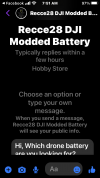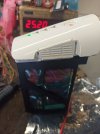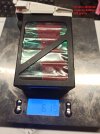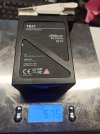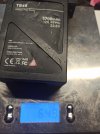I tried to find vincentNG in Facebook. There are several of them. Which one do I need to contact?USD at $500 plus shipping, X8 = $4,000 +shipping
You are using an out of date browser. It may not display this or other websites correctly.
You should upgrade or use an alternative browser.
You should upgrade or use an alternative browser.
Cruzroy Battery Mod
- Thread starter WilsonFlyer
- Start date
- Joined
- Dec 14, 2017
- Messages
- 328
- Reaction score
- 138
- Age
- 61
I tried to find vincentNG in Facebook. There are several of them. Which one do I need to contact?
- Joined
- Dec 14, 2017
- Messages
- 328
- Reaction score
- 138
- Age
- 61
I tried to find vincentNG in Facebook. There are several of them. Which one do I need to contact?
Attachments
Where can I buy one you have a link ?you see in the photo what charger that i use, the 9000 takes about 10 minutes longer than a tb48 put in at same time, there are 2 dji chargers, low watt and high watt, i have multiple batteries i could not stand 1 at time,so i got power chargers
and yes i understand, the 9000 i bought is direct connected for that reason.....it will brick the head, i did a test on something sent to me about if you have bad head, just open and pull balance lead and it will reset.....it made it worst.....BQ chips dont have rom battery, so no power they reset,
thats what was wrong with my first and second build, i was so happy to pull almost 29 miutes off 7000 HV lipo but i disconnected head to remove and bricked it, if you had passwords and BQstudio and a ev2300, you could repair, but i dont know if my old brain can handle more info
- Joined
- Dec 14, 2017
- Messages
- 328
- Reaction score
- 138
- Age
- 61
the 9000 mah or 12000 mah no link but i have info at homeWhere can I buy one you have a link ?
- Joined
- Dec 13, 2015
- Messages
- 920
- Reaction score
- 496
- Age
- 77
Wow, 7000mAh pulled from 680 grams?! That's excellent power density! Please share more details with us (parts sourcing, assembly etc.), photos and testing results so the community will benefit from your experience. To many of us "18650" or "21700" may sound too enigmaticHi all.......just done a tb47 with 18650.looking good so far high discharge 7000mah and 680gramms 12 cells,Will try with 21700 just waiting for deliveries
Last edited:
Really very simple and surprised nobody has tried 18650/21700 route !.You must use high discharge /low resistance cells .But ideally considering shortage of batteries Molicell 4200mah.6s2p configuration will be ideal and will be trying shortly..Unfortunately you are unable to use Dji charger and need to charge externally.However if you can obtain some of the Dell laptop cells of which are fully charged voltage 4.30-4-35 these would be ideal and can use dji charger as normal i believe however you would need to use 6s4p min config as they are low discharge cells but relatively high capacity ie approx 24 cells=12000mah.Have not tried this yet ! but believe very plausable.I noticed online you can change a resistor on the head to adjust capacity shown ect(cruzroy youtube comment).The battery i made was just a tester and is not causing any errors as yet but the cells are old and looking forward to the 21700 cells and will update.
- Joined
- Jan 16, 2021
- Messages
- 178
- Reaction score
- 78
- Age
- 55
First off I want to say the reason why no-one will ever use 18650 or 21700 batteries is because they are wasteful for both space and weight.
You also have to discuss the fact they are NOT LiPoHV cells. The C rating is nowhere near what is necessary, thus you run the REAL risk of them bursting into fire during discharge (ie, in flight).
There is a reason why pouch-packed LiPoHV cells are the ONLY thing used in drone batteries. To discuss any other solution is just nonsense. This is one place the manufacturers did their homework.
Basically, LiPo tech is so mature of a technology that it is REALLY simple. A given weight of battery pack has a given capacity. Doesn't matter form factor, doesn't matter how little or how many cells. Sure you have regular LiPo and LiPoHV, but again, it all comes down to a given density for a given capacity. There is no free lunch.
Same with cell sizes, a given cell size (H x W x D) will produce a given amount of energy. The way some manufacturers do their ratings is to scheme/scam and misrepresent a lower output product as a higher output product. Fact of the matter is the cells that DJI uses are all proprietary and are made for them for their cell packs. None are universal, not readily available. (Parrot and a few others used universal off-the-shelf LiPo packs and thus their batteries are most certainly reproducible and rebuildable)
I am dead in the middle of dealing with a Chinese LiPo manufacturer on this EXACT issue right now with tons of cash wrapped up in it. Fact of the matter is LiPo chemical technology is what it is. Thus a given size/weight will tell you how much true capacity and voltage can be supported. The actual cells used and their characteristics determine the final values, but size/weight can give you a good idea if the capacity stated is honest or not. Again, you cannot get more density than what is offered by the chemistry.
You also have to discuss the fact they are NOT LiPoHV cells. The C rating is nowhere near what is necessary, thus you run the REAL risk of them bursting into fire during discharge (ie, in flight).
There is a reason why pouch-packed LiPoHV cells are the ONLY thing used in drone batteries. To discuss any other solution is just nonsense. This is one place the manufacturers did their homework.
Basically, LiPo tech is so mature of a technology that it is REALLY simple. A given weight of battery pack has a given capacity. Doesn't matter form factor, doesn't matter how little or how many cells. Sure you have regular LiPo and LiPoHV, but again, it all comes down to a given density for a given capacity. There is no free lunch.
Same with cell sizes, a given cell size (H x W x D) will produce a given amount of energy. The way some manufacturers do their ratings is to scheme/scam and misrepresent a lower output product as a higher output product. Fact of the matter is the cells that DJI uses are all proprietary and are made for them for their cell packs. None are universal, not readily available. (Parrot and a few others used universal off-the-shelf LiPo packs and thus their batteries are most certainly reproducible and rebuildable)
I am dead in the middle of dealing with a Chinese LiPo manufacturer on this EXACT issue right now with tons of cash wrapped up in it. Fact of the matter is LiPo chemical technology is what it is. Thus a given size/weight will tell you how much true capacity and voltage can be supported. The actual cells used and their characteristics determine the final values, but size/weight can give you a good idea if the capacity stated is honest or not. Again, you cannot get more density than what is offered by the chemistry.
- Joined
- Jan 16, 2021
- Messages
- 178
- Reaction score
- 78
- Age
- 55
And just to follow up, I made some generalizations based on power density and formulation, but the fact of the matter is LiPoHV cells must be used in this application with a given discharge rate to be safe. That is basically the larger framework we work under when trying to determine which cells can be used in this application.
You also have to take into consideration packaging of individual cells when looking at density. This is done for a number of reasons, with those being heat dissipation (smaller individual cells can recover easier than larger monolithic cells if there is a methodology employed to help dissipate heat between cells), chemical stability and stratification as well as the "safety" factor involved with multiple cells.
You also have to take into consideration packaging of individual cells when looking at density. This is done for a number of reasons, with those being heat dissipation (smaller individual cells can recover easier than larger monolithic cells if there is a methodology employed to help dissipate heat between cells), chemical stability and stratification as well as the "safety" factor involved with multiple cells.
Must admit i do understand your criticism considering you have invested a lot of money in compatible cells.Regarding your first point."The C rating"What is the c rating of a single cell from a tb47 ?I believe you may hit 20-25 amps max in flight !.Not sure if you are aware of the newer technology regarding density but one of the available cells at the moment is Molicell 4200mah with discharge rate of 30 amps x2 60 amps max discharge and 8400 mah with total weight of 804 grams(12 cells).You need to look back to when the tb47/48 was starting production and your point would have been valid back then but technology has moved considerably since 2013.Heat...mmmmm well must say i think everyone has seen enough dji swollen batteries and i believe a lot of the time it is the one right in the middle of the pack.Unfortunately with all manufacturers homework they forgot that when you squeeze so many cells into a tight space without any circulation catastrophic results occur.With 21700/18650 they do have ventilation and a metal outer shell which dissipates heat well.You said"There is a reason why pouch-packed LiPoHV cells are the ONLY thing used in drone batteries" and "First off I want to say the reason why no-one will ever use 18650 or 21700 batteries is because they are wasteful for both space and weight." DJI actually use 18650 in the mavic mini.Think investing in battery technology at the moment is very risky ! and especially in china as there is a genuine reason why we are unable to get many types of batteries at the moment.
- Joined
- Jan 16, 2021
- Messages
- 178
- Reaction score
- 78
- Age
- 55
Actually, my investing in anything has nothing to do with common sense. My criticism has everything to do with solid engineering principles, nothing less. And who said I am looking at compatible cells. I am looking at ANY cells that meet the criteria to be used in making alternatives to the no-longer-available DJI battery packs.
Metal cased batteries add unneeded weight. Weight is THE big thing with batteries. To argue otherwise is a non-starter.
The Mavic-Mini has NOTHING to do with an Inspire 1. It is in a TOTALLY different classification in ALL aspects (size, weight, capability, etc, etc, etc). To argue they use a metal-cased battery in it means NOTHING. There is ZERO reason to even make that comparison. Any more argument about a metal cased battery just goes to show that you refuse to understand that ANY extra unnecessary weight is NOT ALLOWED AT ALL, PERIOD. You can't even go on to mention anything else. Wasted weight on a drone the size of the Inspire series is just that a waste. We have large cameras to use and ANYTHING extra works against the fact that there is a limit to the power of the motors the drone is equipped with. And last I checked, this discussion was about batteries, not about changing the motors or other related parts to support more weight, and that is what would need to be done. As it stands there is diminished returns from larger battery packs over the TB47/TB48 size in regards to extra heat being generated inside the batteries, flight times, agility, ability for proper flight and even the ability to carry given payloads to performs the job at hand. Ultimately there is a point where reliability falls off a cliff because you have severely overloaded the capacity of the motors.
Again, there are a ton of factors involved, but metal-cased batteries are a non-starter for the Inspire 1. Anyone that thinks that is a solution doesn't really care about the longevity of their aircraft.
Metal cased batteries add unneeded weight. Weight is THE big thing with batteries. To argue otherwise is a non-starter.
The Mavic-Mini has NOTHING to do with an Inspire 1. It is in a TOTALLY different classification in ALL aspects (size, weight, capability, etc, etc, etc). To argue they use a metal-cased battery in it means NOTHING. There is ZERO reason to even make that comparison. Any more argument about a metal cased battery just goes to show that you refuse to understand that ANY extra unnecessary weight is NOT ALLOWED AT ALL, PERIOD. You can't even go on to mention anything else. Wasted weight on a drone the size of the Inspire series is just that a waste. We have large cameras to use and ANYTHING extra works against the fact that there is a limit to the power of the motors the drone is equipped with. And last I checked, this discussion was about batteries, not about changing the motors or other related parts to support more weight, and that is what would need to be done. As it stands there is diminished returns from larger battery packs over the TB47/TB48 size in regards to extra heat being generated inside the batteries, flight times, agility, ability for proper flight and even the ability to carry given payloads to performs the job at hand. Ultimately there is a point where reliability falls off a cliff because you have severely overloaded the capacity of the motors.
Again, there are a ton of factors involved, but metal-cased batteries are a non-starter for the Inspire 1. Anyone that thinks that is a solution doesn't really care about the longevity of their aircraft.
Regarding common sense i just thought it was unwise to invest in battery technology at the moment.You really have contributed nothing to the substantiate your claim "There is a reason why pouch-packed LiPoHV cells are the ONLY thing used in drone batteries. To discuss any other solution is just nonsense."Sorry but afraid you are not the type of person i want to discuss this topic any more as you are unable to contribute any knowledge i feel would be beneficial.
- Joined
- Jan 16, 2021
- Messages
- 178
- Reaction score
- 78
- Age
- 55
Well, it would seem as if you have seen some "common sense" in regards to METAL cased batteries being unwise in the Inspire 1.
I can see the Mavic Mini using a metal cased battery... Why not, it is super-light already, and they were trying to cut costs, and metal-cased LiPo cells are cheaper than the higher capacity pouch-based offerings (which are, quite frankly, viewed as a premium custom-cell option). Luckily, for us consumers, pouch-based LiPo cells have become in so demand they are becoming available via "universal" sizes and offerings.
And to substantiate, again, ALL the manufacturers for high-end products offer ONLY batteries with pouch-based LiPo cells. There is a REASON for that, and it is weight and space. You can get more capacity in a smaller space with less weight with pouch-based LiPo vs round cylindrical metal canister based LiPo cells.
Oh, and I know Tesla uses round metal canister cells, but that is for safety and stability concerns (metal canister cells are a easier "sell" safety-wise for the general public) when you have thousands in one vehicle to provide for its power source. A crash will result in some crushed cells, but more will just breakout and absorb impact better than pouch-based offerings. I read all the technical stuff on that when they came out and it makes a lot of common sense. The same needs do not apply to drones.
And by that I mean that you are stuck with a very space-hungry battery design (round). You can get much more capacity by utilizing pouch-based LiPo technology. That is why the Mavic Air, Mavic Air 2, Mavic Pro, Mavic 2 Pro/Zoom, Inspire1, Inspire2, Phantom 4 (all), Phantom 3 and I believe it goes all the way back to Phantom 2 at least for pouch-based LiPo battery cells. Not to Mention the Parrot Anafi, Skydio offerings and the Autel offerings, ALL utilize LiPo pouch-based cells.I can see the Mavic Mini using a metal cased battery... Why not, it is super-light already, and they were trying to cut costs, and metal-cased LiPo cells are cheaper than the higher capacity pouch-based offerings (which are, quite frankly, viewed as a premium custom-cell option). Luckily, for us consumers, pouch-based LiPo cells have become in so demand they are becoming available via "universal" sizes and offerings.
And to substantiate, again, ALL the manufacturers for high-end products offer ONLY batteries with pouch-based LiPo cells. There is a REASON for that, and it is weight and space. You can get more capacity in a smaller space with less weight with pouch-based LiPo vs round cylindrical metal canister based LiPo cells.
Oh, and I know Tesla uses round metal canister cells, but that is for safety and stability concerns (metal canister cells are a easier "sell" safety-wise for the general public) when you have thousands in one vehicle to provide for its power source. A crash will result in some crushed cells, but more will just breakout and absorb impact better than pouch-based offerings. I read all the technical stuff on that when they came out and it makes a lot of common sense. The same needs do not apply to drones.
- Joined
- Dec 13, 2015
- Messages
- 920
- Reaction score
- 496
- Age
- 77
Although Brian's and rokz's discussion is going unnecessarily overheated, on behalf of our community I appreciate their input. Myself I spent a big deal of time and money already trying to find a reliable solution for TB47/48 battery packs, but I've stumbled into a pile of Chinese garbage ... The reason for my scepticism is the lack of readily accessible raw LiPo cells for further experimentation. In order to successfully come up with some solution one will have to live in Shen Zhen or nearby ... I'm pretty sure DJI is selecting raw cells to match Internal resistance and capacity for 2P configuration. These parameters can vary wildly, as I noticed myself after receiving a shipment of prohibitively expensive set of 12 raw cells claimed to be a direct replacement for TB48 cells. Cells arrived un-labelled, un-marked and of unknown parameters. For this reason alone I will rather cannibalize a new TB48S battery and transplant the whole pack. Here, in NA, we don't have resources for this project ...
- Joined
- Dec 13, 2015
- Messages
- 920
- Reaction score
- 496
- Age
- 77
Pictures are OK, but the battery performance is the one and only proof of successful application. In this case the pack is heavier and of lower capacity than original, therefore you can't expect more than 5-6 minutes of flight ... assuming that the pack will deliver enough juice ... I strongly recommend low hovering test without camera, observing cell's voltage drop on dedicated app page ... Keep us posted, please!Maybe pictures might be easier to understand ! ...will weigh slightly more when fitted with molicell cells....
Yes i totally agree with your logic and sorry to hear about your bad experiences in trying to overcome this hurdle.I think the only place compatible cells are available is India.The Chinese cells are not what they claim.This is the main reason i think a different approach is needed.Hence my project.I do believe that things are possible if you are willing to put the effort in and fortunately i am in a position that i can try different approaches as i have 2-300 of these packs with failed cells
Similar threads
- Replies
- 1
- Views
- 2K
- Replies
- 5
- Views
- 776
- Replies
- 0
- Views
- 578
- Replies
- 5
- Views
- 607
New Posts
-
MY INSPIRE 2 SPEED IS STUCK AT 15 MPH. HOW DO I INCREASE THE SPEED ?
- Latest: topflight9393
-
-
-



